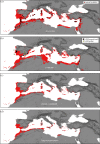The complex history of the olive tree: from Late Quaternary diversification of Mediterranean lineages to primary domestication in the northern Levant
- PMID: 23390107
- PMCID: PMC3574375
- DOI: 10.1098/rspb.2012.2833
The complex history of the olive tree: from Late Quaternary diversification of Mediterranean lineages to primary domestication in the northern Levant
Abstract
The location and timing of domestication of the olive tree, a key crop in Early Mediterranean societies, remain hotly debated. Here, we unravel the history of wild olives (oleasters), and then infer the primary origins of the domesticated olive. Phylogeography and Bayesian molecular dating analyses based on plastid genome profiling of 1263 oleasters and 534 cultivated genotypes reveal three main lineages of pre-Quaternary origin. Regional hotspots of plastid diversity, species distribution modelling and macrofossils support the existence of three long-term refugia; namely the Near East (including Cyprus), the Aegean area and the Strait of Gibraltar. These ancestral wild gene pools have provided the essential foundations for cultivated olive breeding. Comparison of the geographical pattern of plastid diversity between wild and cultivated olives indicates the cradle of first domestication in the northern Levant followed by dispersals across the Mediterranean basin in parallel with the expansion of civilizations and human exchanges in this part of the world.
Figures


References
-
- Diamond J. 2002. Evolution, consequences and future of plant and animal domestication. Nature 418, 700–70710.1038/nature01019 (doi:10.1038/nature01019) - DOI - DOI - PubMed
-
- Zohary D, Hopf M, Weiss E. 2012. Domestication of plants in the Old World: The origin and spread of cultivated plants in Southwest Asia, Europe, and the Mediterranean basin. Oxford, UK: Oxford University Press
-
- Carrión Y, Ntinou M, Badal E. 2010. Olea europaea L. in the North Mediterranean Basin during the Pleniglacial and the Early–Middle Holocene. Q. Sci. Rev. 29, 952–96810.1016/j.quascirev.2009.12.015 (doi:10.1016/j.quascirev.2009.12.015) - DOI - DOI
-
- Kaniewski D, Van Campo E, Boiy T, Terral JF, Khadari B, Besnard G, 2012. Primary domestication and early uses of the emblematic olive tree: palaeobotanical, historical and molecular evidences from the middle east. Biol. Rev. 87, 885–89910.1111/j.1469-185X.2012.00229.x (doi:10.1111/j.1469-185X.2012.00229.x) - DOI - DOI - PubMed
-
- Blondel JJ, Aronson J, Bodiou JY, Boeuf G. 2010. The Mediterranean region: biological diversity in space and time. Oxford, UK: Oxford University Press
Publication types
MeSH terms
LinkOut - more resources
Full Text Sources
Other Literature Sources

